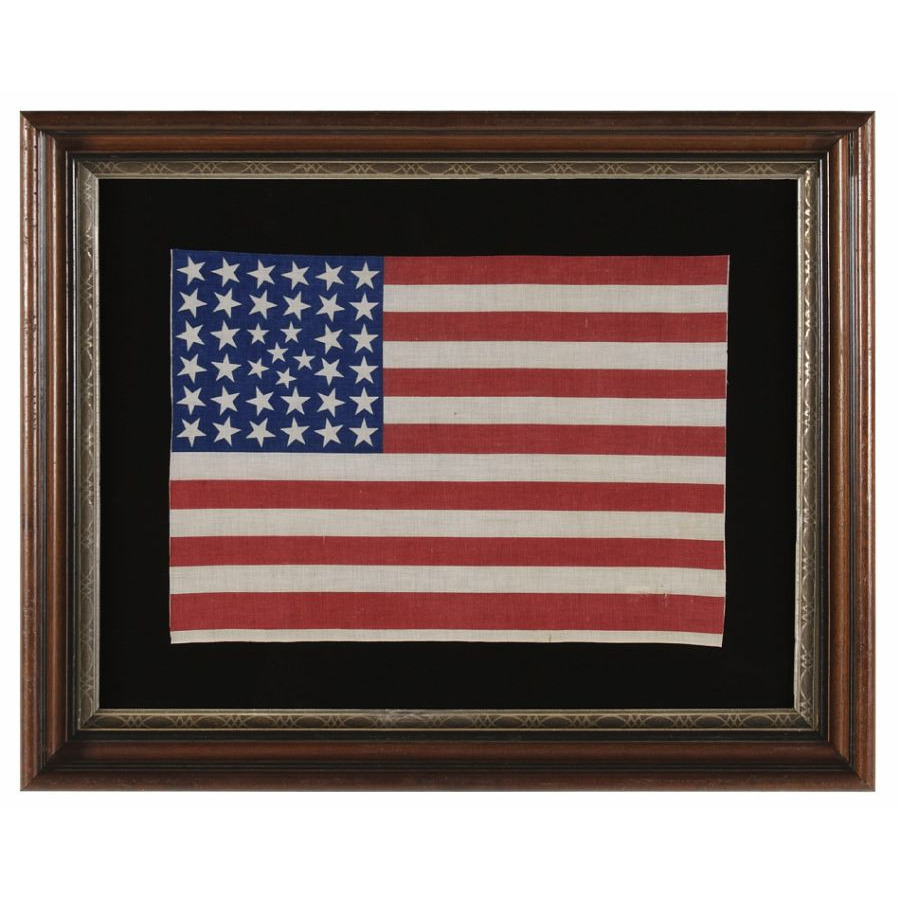
| |
38 STARS IN AN EXTREMELY RARE PATTERN THAT BEARS A CLUSTER OF 6 SMALL STARS WITHIN A LINEAL PATTERN OF LARGER STARS, 1876-1889, COLORADO STATEHOOD |
|
| Available: |
Sold |
| Frame Size (H x L): |
21.5" x 26.5" |
| Flag Size (H x L): |
12.75" x 17.5" |
|
| Description....: |
|
38 STARS IN AN EXTREMELY RARE PATTERN THAT BEARS A CLUSTER OF 6 SMALL STARS WITHIN A LINEAL PATTERN OF LARGER STARS, 1876-1889, COLORADO STATEHOOD:
38 star American national parade flag, printed on cotton. This is an extremely rare example of a lineal pattern flag with a wreath or cluster of smaller stars inserted in the center. Only a handful of flags in this style are known to have survived, the colors of which are typically saturated and vibrant, like this example, in dark scarlet red and royal blue.
The particular wreath in the center of the configuration is really more of a pentagon with a single, center star. The reason for the choice of the design and 6 smaller stars seems a curious one on the surface, but its purpose was probably nothing more than to simply augment a 36 star print block to one with 38 stars. One may observe how 4 stars, that would have comprised the center of a 6 x 6 pattern, could have simply been removed and 6 smaller stars inserted in their place, in an artful fashion.
At least two other similar 38-star patterns are known that incorporate 4 small stars intermingled between rows of what most certainly were two very similar 34-star flag print blocks originally. It was easier to modify these blocks rather than create brand new ones. In these particular instances, the results are rare, quirky configurations that are highly prized by collectors.
Colorado became the 38th state on August 1st, 1876. This was the year of our nation’s centennial of independence from Great Britain. Although 37 was the official star count for the American flag in 1876, flag-making was a competitive venture, and no one wanted to be making 37 star flags when others were making 38’s. It is for this reason that 38 and 13 stars (to represent the original 13 colonies) are the two star counts most often seen at the Centennial International Exposition, the six-month long, World’s Fair event, held in honor of the anniversary, in Philadelphia. Some flag-makers were actually producing 39 star flags, in hopeful anticipation of the addition of another Western Territory. The 38 star flag became official on July 4th, 1877 and was generally used until the addition of the Dakotas in 1889.
Mounting: The solid walnut molding has a substantial profile, ebonized trim, a gilded liner with fanciful silhouetted decoration, and dates to the dates to the period between 1870 and the 1880's. The flag has been hand-stitched to a background of 100% cotton twill, black in color. The cotton was washed to remove excess dye. An acid-free agent was added to the wash to further set the dye and the fabric was heat-treated for the same purpose. Spacers keep the textile away from the glazing, which is U.V. protective glass.
Condition: Overall exceptional for the period. There are 2 small tears between the 12th and 13th stripes at the fly end. There are a couple of very tiny stains of little to no significance. |
|
|
|
| Collector Level: |
Advanced Collectors and the Person with Everything |
|
| Flag Type: |
Parade flag |
|
| Star Count: |
38 |
|
| Earliest Date of Origin: |
1876 |
|
| Latest Date of Origin: |
1889 |
|
| State/Affiliation: |
Colorado |
|
| War Association: |
1866-1890 Indian Wars |
|
| Price: |
SOLD |
|
| |
Views: 3031 |
|
|
|

